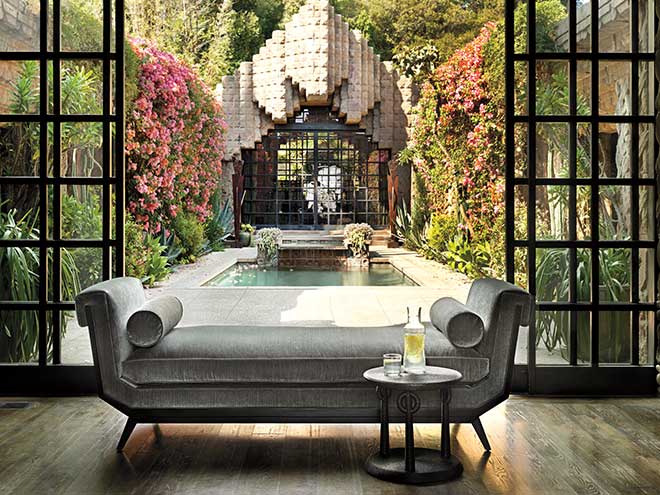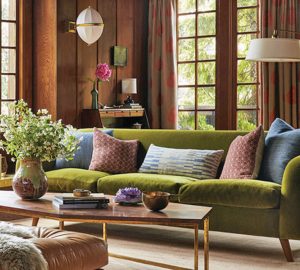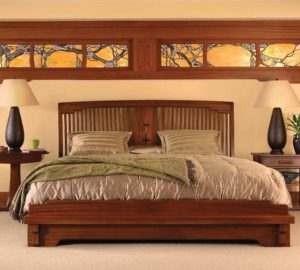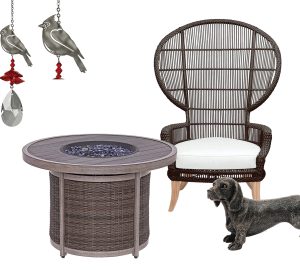baker furniture
We recognize the name Baker as meaning quality in furniture. But what we don’t know is all the permutations this company has gone through and still, it comes out with wonderful furniture lines created by top designers. In 1893, the first piece of Baker Furniture was designed and created: a desk/bookcase in Grand Rapids, Michigan, by the company founder, Dutch immigrant Siebe Baker.
Siebe Baker’s son Hollis S. joined the company in 1910 and became president in 1925, just in time for the Art Deco movement. The Baker line helped launch the Modern Movement in furniture design shortly thereafter, when Joseph Urban (the famed designer of Mar a Lago for Marjorie Meriwether Post) was contracted to design bedroom furniture, as was Kem Weber.
The company always was ahead of the design curve, as you will see. In 1929, Baker came out with the Manor House line, a nod to the classics that copied antiques— the first brand in the U.S. to do so. Again, ahead of the design curve, Baker introduced Chinese Modern at the 1934 Chicago World’s Fair.
Meanwhile, Hollis S. had been amassing a fine collection of antiques, and in 1941, more than 1,500 of them were placed on display securing his position as one of the largest collectors of antiques in the world. At the end of the 1940s, Baker launched its Far East collection, the first truly Asian designed and manufactured furniture in the United States. The Palladian Collection, a tribute to museum originals, followed.
Finn Juhl got the 1950s off to a fun start by designing Baker’s first Danish Modern collection. In addition, the Milling Road line came out of the company’s purchase of the Grand Rapids Chair Co., which was a way to offer quality furnishings at a lower price point.
In 1961, Hollis’ son, Hollis M., became president and the expansion continued. Production expanded to Mockville, North Carolina, and the trend of French provincial and English furniture. In 1969, Baker was sold to Magnavox Inc. and then a series of other corporations, and the Baker family was no longer involved.
In 1972, Baker merged with a well-established trade showroom and became Baker, Knapp & Tubbs. It launched its Historic Charleston collection in 1976, one of its most successful. The ’80s introduced The Stately Home Collection and a partnership with John Sladino, another well-known designer.
In 1986, the Kohler plumbing family purchased Baker. As plumbers, they had little choice but to use interior designers to create the look of their product, including Barbara Barry, McMillen, Bill Sofield, Thomas Pheasant, Laura Kirar, Michael S. Smith and Jacques Garcia. This took the company truly global, with showrooms in Paris, Moscow, Singapore and China.
This year, Baker was sold to Hong Kong-based Samson Holding Ltd. for $35 million, marking the end of an era for this most American of furniture lines.
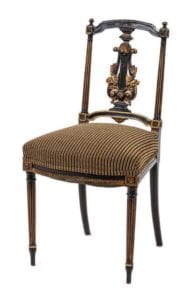 come to terms with … Louis XVI-style side chair
come to terms with … Louis XVI-style side chair
As you know, I love auctions. We are still sprucing up our Palm Beach condo, so I thought I would see what items I could win at the latest Leslie Hindman Palm Beach auction. Success! I purchased a Louis XVI-style, gilt-painted side chair. The description states: 19th century, having a carved lyre-form back and upholstered seat, raised on tapered fluted legs. Let’s discuss each part step by step, shall we?
→ 19th Century: Attributed to being manufactured at some time in the 1800s.
→ Louis XVI-style: My chair probably represents the later part of this period, which had a more neoclassical look, from 1774-1793.
→ Gilt-painted: Gold leaf has been applied to highlight certain areas of the carved wood on the chair.
→ Side chair: A chair without arms
→ Lyre-form back: Pierced splats in the back are in the shape of the musical instrument, the lyre.
→ Tapered fluted legs: Legs that decrease in size from top to bottom and are carved with shallow concave channels.
→ Upholstered seat: A cloth-covered seat
I love chairs and am a firm believer you can never have too many. This little gem most likely will be used as a pull up in our living room to add extra seating.
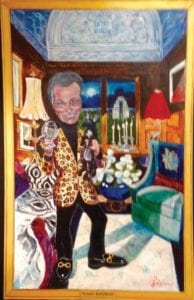 inside look: portraiture
inside look: portraiture
Portraiture has been around since prehistoric times. People have always wanted to freeze time and record their images for posterity. Look at social media and the selfie craze!
What is so fascinating about capturing your image in a permanent way? For one thing, we like to think that portraits are not merely about physical appearance, but also about capturing personality. For another, we are amazed at one human’s ability to recreate the image of another. That is an enviable skill not everyone possesses—only the talented few.
About 10 years ago, I was approached by local artist and gallery owner Philip Slein about painting my portrait. I must admit the idea was daunting. My mother had my father’s portrait painted after he passed away, to display it in our family’s company headquarters. So the idea wasn’t completely foreign to me.
If I was going to have one done, Philip was the person to do it, I thought. He had painted several people I knew, and I loved his ability to really capture personality. So, a photo shoot ensued. The result is a 4-by-6-foot canvas that captures my love for life. I encourage you to take the plunge and freeze time on canvas just for the fun of it! It will make you smile every time you look at it.
Pictured: The Lola Chaise
Photo courtesy of KDR Designer Showrooms





